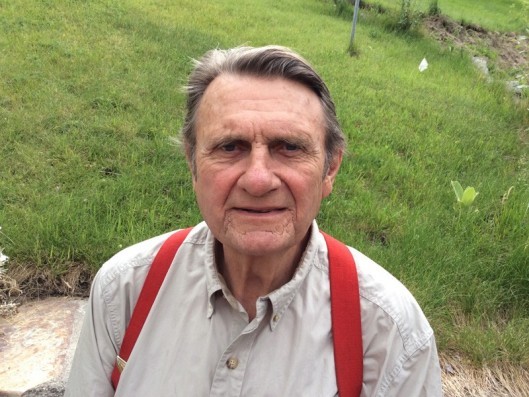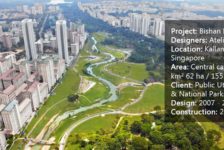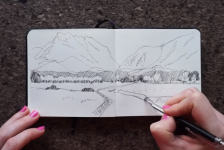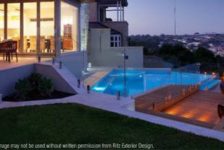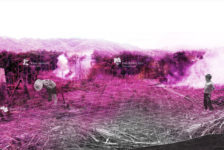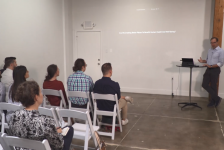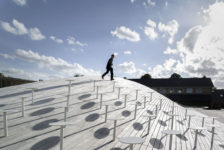The Landscape Architecture Foundation (LAF) Summit on Landscape Architecture and the Future is over. Landscape architects have returned home all over the country and all over the world. Over 715 landscape architects convened on the campus of the University of Pennsylvania on June 10th and 11th. Attendees came from as far as China, Argentina, and Australia. Many of the world’s preeminent designers, scholars, teachers, advocates, technologists, humanists, feminists, naturalists, and urbanists whom align with the field of landscape architecture were present. They gathered to build upon and redefine the 1966 Declaration of Concern. But, will their efforts make a difference? Will this summit cause any significant change in our profession or our world?
While following the #LAFSummit hashtag on social media you may have felt less than excited about the next fifty years of our profession. Or as one tweeter put it, and I loosely paraphrase, it seemed as though the information streaming live was nothing more than a string of vague intangible platitudes. With any amount of luck, we at Land8.com can help fill in the pieces of a very disjointed puzzle known as the #LAFSummit.
Before the Summit
For those of you who are not familiar with the summit nor the impetus for the meeting, we have to travel very briefly back to the 1960’s. The 1960’s were, to say the least, a decade of change and conflict. Political strife, assassinations, wars, civil rights movements for equality in race, sexual orientation, gender, the expansion of scientific exploration, psychedelic music, hippies, and frisbees. It seemed that if something happened…then it happened in the 1960’s. The 1960’s set the scene for much of what has taken place in the United States over the past five decades.
This time of tension and buildup of political and environmental concern was met in June 1966 by six individuals who were concerned with the future direction of our country. More specifically, they were concerned with “the misuse of the environment and development which has lost all context with the basic processes of nature.” Grady Clay, Charles R. Hammond, Ian L. McHarg, Campbell Miller, George E Patton, and John O. Simonds met at Independence Hall in Philadelphia to sound the alarm. In this meeting, they established a four-point program: 1. Recruitment. 2. Education. 3. Research. 4. A system for communicating the results of research, example, and good practice. Through this program, landscape architects would “multiply the effectiveness of the limited number of landscape architects, while producing more trained people to cope with the future environment.”
The gloves were off, the challenge made. But did it make a difference? Did landscape architects hear the call? Did they respond? Did they produce “collaborative solutions”?
Why a Summit?
Some would say that landscape architects have answered the call while others would disagree. Surely though the slew of ecological agencies, numerous books and social movements which followed the 1960’s would suggest that many people heard and answered the larger national call the call. And certainly whether landscape architects were a part of these movements is to some degree not debated.
But why now? Why a summit? Obviously we are fifty years past the original declaration. A lot has changed in fifty years in our profession, in our country, even globally. Our world is faced with similar, if not the same, problems of equity, ecology, politics, programming, and more. Our scales have shifted to include global ecologies, the distribution of goods and bads, and global markets.
The summit was called to reflect on, to celebrate, and critically examine the past fifty years and make declarations of intent for the coming fifty years. The summit provided a precipice from which to gain perspective. Also, unlike conferences or seminars, a summit provides the opportunity for leaders to gather for the purposes of challenging, wrestling, arguing, reflecting, and projecting. It is the setting where one should go big or go home.
Day 1
Day one was met with twenty-four declarations presented in a Pecha kucha like format. These declarations were made by seasoned professionals from the U.S., Canada, Mexico, Colombia, China, Australia, New Zealand, the U.K., the Netherlands, France, Switzerland, and Germany. The range of topics was spread wide and emotions were raw. Developing Landscapes of Resources Management (Alpa Nawre), Into an Era of Landscape Humanism (Gina Ford), The Art of Survival (Kongjian Yu), Landscape City (James Corner), Life Liberty and the Pursuit of Sustainable Happiness: Actions for Interdependence (Randy Hester), and Activist Landscape/Civic Stewardship (Kate Orff) were only a small portion of the declarations made.
Randy Hester (Image|Cameron R. Rodman)
Through these declarations, everyone was challenged to move forward. To recognize the past as it was, the current as it is, and to lead in the next fifty years. In the next fifty years, our wicked problems will become more layered and complex. Our resources will need to be managed more actively and intelligently, especially in developing countries, and our language of communication to the everyday person will need to develop. Nawre challenges, “There must be a crusading determination on the part of landscape architects to address designs that manage resources critical to human well-being if we are ever to permanently establish and realize the maximum potential of our discipline.” With the ever increasing globalization or our world and our melting pot nation, Gina Ford, ASLA urged landscape architects to diversify our profession, design with equity in mind, and to collaborate and take the lead on our future problems.
This rousing series of declarations was closed by renowned Landscape Architects Cornelia Hahn Obelander, Peter Walker, and Laurie Olin. Taking a retrospective look on their experience in the profession and the transition of the field helped to join the previous fifty years with the preceding declarations.
 Laurie Olin, Peter Walker, Cornelia Hahn Oberlander -:Left to Right (Image|Cameron R. Rodman)
Laurie Olin, Peter Walker, Cornelia Hahn Oberlander -:Left to Right (Image|Cameron R. Rodman)
LAF’s 50th Anniversary Celebration and Dinner
After a long and exciting day of stirring challenges, many of the attendees and presenters celebrated the evening at the National Constitution Center. Here LAF awarded the first LAF Medal and the first Founder’s Award. The LAF Medal is given to “a landscape architect for distinguished work over a career in applying the principles of sustainability to landscapes.” The 2016 LAF Medal was awarded to Grant Jones for his innovative work in “the 1980’s and 1990s in many areas”. The 2016 Founder’s Award was given to the American Society of Landscape Architects. The award is “given to a firm, agency, or organization that demonstrates a significant commitment to preserving, creating, or enhancing landscapes over a sustained period of time.” Without a doubt, this is a well-deserved recognition that has been in the making since 1899.
Grant Jones (Image|LAF)
During the evening, LAF also announced a huge campaign that will continue to change the face of our profession. The 50 & Forward Campaign has raised $3,281,000 of their $3.5 million goal. These funds are set aside for creating new programs and expanding the existing programs at LAF. It is the hope of LAF to diversify the pool of talent, lead a forum for practicing LA’s, invest in new research, expand research grants, increase scholarships and fellowships, and expand their capacity and the capacity of the profession to “communicate the value of landscape architecture and exemplary design.”
These goals are being supported with the creation of the ‘LAF Fellowship for Innovation and Leadership’. “The fellowship is an opportunity for current landscape architects to develop transformational leadership capacity through research and an entrepreneurial approach to the incubation of ideas. It is designed as a time to reflect, research, explore, create, test, and develop ideas into action.”
Day 2
If one thought that day two could not top day one’s back to back list of declarations, one was surprised to experience otherwise. Opened by LAF President Kona Gray, the day launched into a back-to-back series of panels on nine topics. Each leader-filled panel was begun with an opening comment followed by brief thought provoking statements from the panel members. Then the crowd was polled for Q&A and a series of final statements were made by the panelist. The crowd peppered the panels with a variety of emotionally charged, deeply thoughtful, and analytical questions which put to test each of the previous day’s declarations as well as the panels opening comments. This was certainly an anything-goes series of Q&A. Most questions imaginable were addressed, and we even saw some obscure questions about Donald Trump and the form one’s patronus would take.
Kona Gray (Image|Cameron R. Rodman)
The focus and purpose of day two was to examine a pre-set series of topics that are being considered as foundational to our ‘New Declaration’. Everyone in the room (on stage and in the crowd) had a vibrant series of opinions which are certainly going to affect the final declaration to be adopted. The panels were on a variety of topics. We’ll only highlight a few, their conversations, and a few choice quotes from the panelists.
*All Panels were moderated by a member of the LAF board of Directors. Each panel member can be explored on the LAF website.
Panel 1: Aesthetics
Moderated by Adam Greenspan
Panel: Claude Cormier, Maria Goula, Gary Hilderbrand, Mikyoung Kim, Chris Reed, Ken Smith
What some landscape architects would conclude to be trivial, this panel took quite seriously. Mikyoung Kim believes that “It’s our obligation to weigh and balance the creative and the critical.” Aesthetics is not simply a shiny coat to package our designs for the mass consumer. It is deeper than the surface appreciation. “Aesthetics are the emotional core of our designs. It’s how we communicate and it should be at the forefront of our declaration.” (Ken Smith)
Panel 2: Ecology
Moderated by Kristina Hill
Panel: Jose Almiñana, Julie Bargmann, Brett Milligan, Ellen Neises, Antje Stokman
Whether ecology should be one of the core tenants of our profession moving into the next fifty years is a line of thinking which has continued to develop since the 1960’s. Discussions of urbanization and global ecologies as well as the Anthropocene are all making ecology a more relevant topic. Without a doubt, we can certainly agree with Brett Millagan, that “ecology is inherently political.” But, regardless of our stance on the politics of ecology, it is becoming clearer that man and nature are not apart from each other. “We reject this false dichotomy of nature and man. We are one.” (Jose Almiñana)
Panel 3: Society
Moderated by Deb Guenther
Panel: Alison Hirsch, Jeffrey Hou, Diane Jones Allen, Anne Whiston Spirn
Society certainly has a strong position in our profession and has for quite some time, but the way in which it presents itself and the way in which we have addressed, it has steadily changed. As our American culture has changed and our global connectivity increased, a growing focus of the profession has moved to diversity. The panel challenged us to not only think of diversity of race but diversity of equity, to be interdependent amongst our communities, and to give voices to the people – not only those at the top. Anne Whiston Spirn put forth a great concept that our efforts should “move from advocacy to capacity building.” A very critical thought which challenges our previous actions of swoop in and save the day to swoop in, hang out, and help the community find it’s voice – to build capacity for change.
Society Panel (Image|Cameron R. Rodman)
Panel 4: Innovation
Moderated by Susannah Drake
Panel: Andrea Hansen, Liat Margolis, Adrian McGregor, Karen M’Closkey, Marcel Wilson
Where does innovation find its place in landscape architecture? In the past decades one might say that LA’s have taken a backseat to the decision making and that we weren’t being innovative enough. As a group, we have tended to be more reactionary in nature, responding to requests for solutions. Technology is changing rapidly too. However, “Technology in and of itself does not foster innovation.” (Karen M’Closkey) So what is the place of innovation in our profession? Should we be blazing new trails towards the future and presenting solutions before questions arise and innovating new ways of building cities, manipulating transportation, integrating technology, heath, mechanics, and nature?
Panel 5: Academic Practice
Moderated by M. Elen Deming
Panel: Anita Berrizbeitia, Jacky Bowring, Julia Czerniak, Susan Herrington, Anuradha Mathur
Academic practice has the distinct opportunity to drive our profession, and setting up the success of academia is arguably one of the best decisions we can make moving forward. Sometimes seen as an outsider to the acting profession of LA, academic practice has the unique capacity to answer a different series of questions which not only inform future decisions of practice but completely redefine those questions which we are being asked as professionals.
Academic Panel (Image|Twitter @Adrian_Benepe)
The remaining panels discussed private practice, public practice, capacity organizations, and a final panel made up of emerging leaders. Unfortunately we cannot review them all here. Each panel had their additions and recommendations for the next 50 years. Private practice will play an important role in the coming years as their critical thinking leads, comprehensive knowledge base expands, and management skills orchestrate. Public practice will be no less vital to bridging the gap with their technical abilities and skills sets. The public sector is now looking to landscape architects more and more to solve our world’s problems: ecological, physical, and social. Two important avenues for building this critical mass is through capacity organizations like the International Federation of Landscape Architect (IFLA), The Urban Land Institute (ULI) and the American Society of Landscape Architects (ASLA). The second avenue is through our future professionals.
Where Do We Go From Here?
Hopefully, now you have at least a vague understanding of the monumentality of this meeting and the breadth and depth of topics covered. A lot has happened in the past 50 years. Many of our problems still linger. We have made some advancements in ridding our society of some of these problems while others still fester. Yet, what now? Where do we go from here, and what is going to happen with this groundswell of conviction and opinion?
Here’s what you need to know. First, don’t fret missing the Summit. Every single declaration, conversation, and panel was recorded and will be released via LAF sometime this summer or fall. In time, a book will be released marking the occasion and the conversations. Watch LAF for more news on this in the coming year.
Regarding the ‘New Landscape Declaration’, “LAF will be working with its board members and focus groups to draft the New Landscape Declaration, based on the presentations, panels, discussions and feedback received at the Summit. The Declaration will be available for public comment in September and will be finalized by October 20 so that it can be presented at the ASLA Annual Meeting in New Orleans.” (LAF)
A lot is happening in our profession right now. Our world is quickly changing. What will you declare? Where will you make your summit?
For more information on The New Landscape Declaration and the Summit, check out these links:
- https://land8.com/profiles/blogs/toward-the-next-50-years-of-landscape-architecture
- https://lafoundation.org/news-events/2016-summit/
- https://lafoundation.org/news-events/blog/2016/05/26/summit-declare/
- https://landscapearchitecturemagazine.org/2016/05/19/we-declare/
- https://dirt.asla.org/2016/06/16/the-new-landscape-declaration-visions-for-the-next-50-years/
- Search Twitter for #LAFSummit
—
Cameron R. Rodman Associate ASLA, is a Landscape Designer at Stewart Inc., a multi-disciplinary design firm in Charlotte, NC. Cameron is also currently a writer for Land8.com and writes on a variety of topics including event coverage, GIS awareness, book reviews, and current landscape architecture designs. Cameron recently completed a year long term as the National Student Representative to the ASLA Board of Trustees where he enhanced social media communications, chapter president training, and student-professional engagement. Cameron’s current work includes a variety of projects ranging in site scale and programming requirements. At Stewart Inc., Cameron is helping lead the development and implementation of GIS tools as a means of site analysis, site design, storytelling, and public engagement. .





